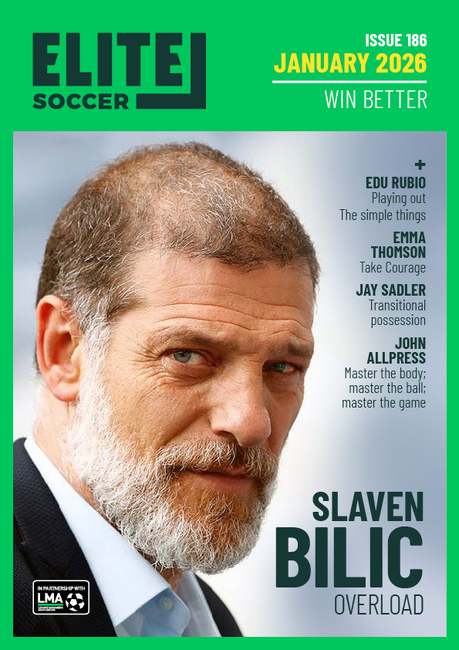




OUR BEST EVER OFFER - SAVE £100/$100
JOIN THE WORLD'S LEADING PROFESSIONAL DEVELOPMENT PROGRAMME
- 12 months membership of Elite Soccer
- Print copy of Elite Player & Coach Development
- Print copy of The Training Ground
You are viewing 1 of your 1 free articles
Supporting the striker
Encourage your players to make forward runs to support the striker. Also, use this session to make attacks lightning fast, with the focus on getting the ball to the striker as quickly as possible.
| Area | Up to two-thirds of pitch |
| Equipment | Balls, bibs, cones, 2 full size goals, 4 small goals |
| No. of Players | 20 players + 2 goalkeepers |
| Session Time | Support the striker: 16mins, Progressions: 16mins each, Small-sided game: 16mins |
This session is all about encouraging players to make forward runs to support the striker. To make attacks lightning fast, it is also focused on getting the ball to the striker as quickly as possible.
We would run this session when we see a team that has defenders and wingers that aren’t very quick and aren’t good at seeing danger and getting into good positions.
What do I get the players to do?
Support the striker
We set up on two thirds of a full size pitch with a goal at each end. A one-yard free zone is marked out across the width of the pitch, 17 yards from the goal, as shown [1].
1
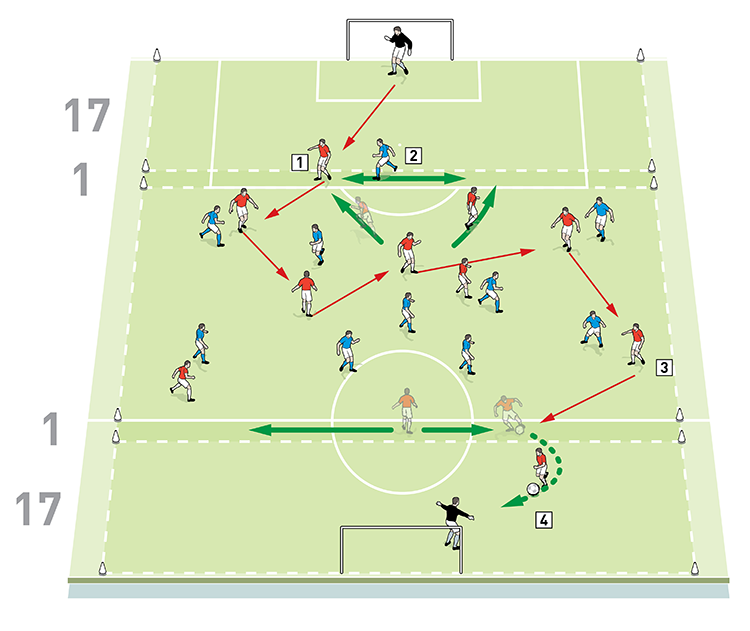
2. One attacker is locked in the free zone but he is not allowed to intercept the pass out from the keeper to the defender
3. Play builds up from the back but after at least three passes are made the ball can be played into the striker in the free zone
4. When the striker receives the ball, he can break out of the free zone but he only has four seconds to score
We’re using 20 outfield players and two goalkeepers, split into two teams of 11. We’re playing 11v11 but one striker for each team starts locked into the free zone.
Play starts with a pass out from one of the goalkeepers. When the keeper has the ball, two defenders can drop into the one-yard free zone to receive the pass and the opposition attacker is not allowed to intercept.
Play then builds up from the back, with the defender passing into the central zone. Teams must make three passes in the central zone before being able to play the ball to their striker in the free zone. The striker can then break out of the free zone to go 1v1 against the goalkeeper, but he has only four seconds to score.
Play four games of four minutes, as it is hard work in the central zone.
How do I progress the session?
Progression 1
We use the same set up, but in the progression two wide attackers are now allowed to run in behind the striker. They give the striker passing options and can go up against the goalkeeper in the penalty area.
In a further progression two defenders are also allowed to go into the penalty area to track the wide attackers, making it 3v2 in favour of the attackers, as shown [2].
2
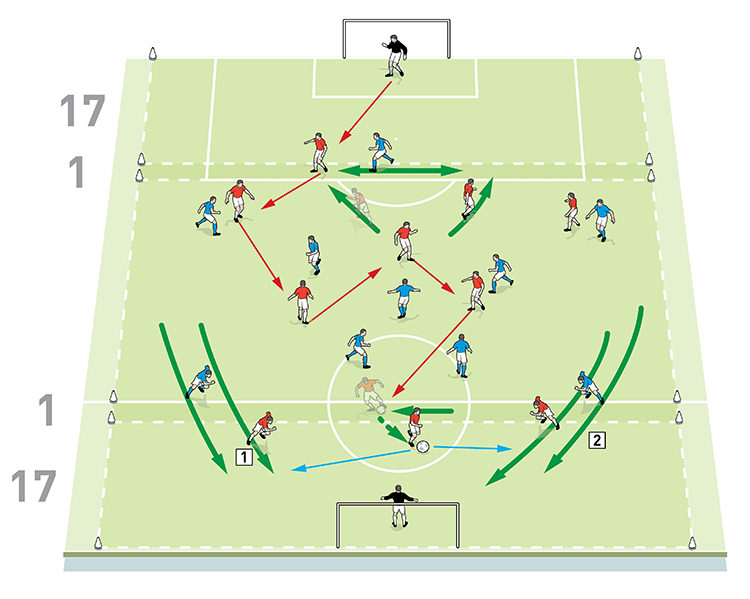
2. Progress further by allowing two defenders to go into the area to track the wide attackers, making it 3v2
Progression 2
We progress the practice further by positioning a defender between the goal and the free zone. As soon as the striker in the free zone has received the ball, the defender can enter the zone to try and win possession, as shown [3].
3
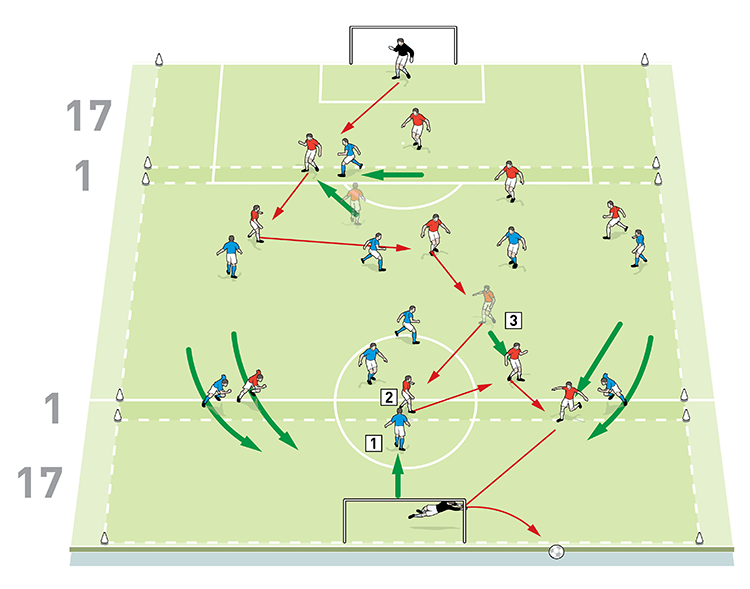
2. When the striker receives the ball, he should be looking to play the ball back and link up with the midfielder
3. A midfielder combines with the striker and can enter the end zone with the wingers and the tracking defenders, making it a 4v3
An extra midfielder can also combine with the striker and cross through the free zone with the two wingers and two defenders, making it a 4v3 in favour of the attackers in front of goal.
When the striker receives the ball he should be looking for opportunities to play it back and link up with the midfielder.
How would you put this into a game situation?
We set up an area of 30x22 yards, with three-yard end zones and one-yard free zones at each end. We position four small goals, as shown [4].
4
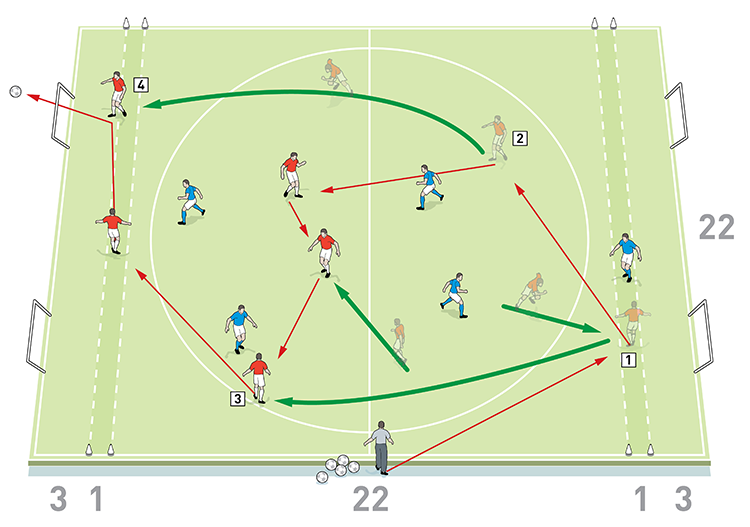
2. The team in possession builds play from the back with good passing
3. The team in possession must make four passes before the ball goes to the striker in the free zone
4. Attackers should make supporting runs into the end zone to receive a pass from the striker and finish in one of the small goals
We are using 10 players, split into two teams of five. It’s 4v4 in the central area and each team has a striker locked in the free zone at the end they are attacking.
Play starts with the coach, who passes into the free zone where one defender has dropped to receive the ball. The team in possession builds up play from the back and must make four passes before the ball can be played to the striker in the free zone. Team mates should now be making supporting runs into the end zone to receive a pass from the striker and finish in one of the target goals.
Progress by allowing a defender to track runs into the end zone.
What are the key things to look out for?
We are looking for the wide attackers to make well-timed runs and to see whether they run inside or make their runs outside. We also want to see quick passing through the midfield to get the ball into the striker as soon as possible.
The striker must be constantly on the move in his free zone so he is always open to a pass from his team mates. If he fails to be a passing option, the session will fail.
What are the typical mistakes players might make and how do I avoid them?
A typical mistake is that players can make too many passes – this can be caused by players missing the chance to hit the striker when the pass is on. To make a success of the session, players must be quick thinking and make the correct decisions.
Also, the wide attacker must be careful not to make his runs too early as he could easily be caught out of position if his midfielders lose possession.
Related Files
Editor's Picks
Attacking transitions
Deep runs in the final third
Using the goalkeeper in build-up play
Intensive boxes drill with goals
Penetrating the final third
Creating and finishing
My philosophy
Pressing initiation
Compact team movement
Coaches' Testimonials

Alan Pardew

Arsène Wenger

Brendan Rodgers

Carlos Carvalhal

José Mourinho

Jürgen Klopp

Pep Guardiola

Roy Hodgson

Sir Alex Ferguson

Steven Gerrard
Coaches' Testimonials

Gerald Kearney, Downtown Las Vegas Soccer Club

Paul Butler, Florida, USA

Rick Shields, Springboro, USA

Tony Green, Pierrefonds Titans, Quebec, Canada
Join the world's leading coaches and managers and discover for yourself one of the best kept secrets in coaching. No other training tool on the planet is written or read by the calibre of names you’ll find in Elite Soccer.
In a recent survey 92% of subscribers said Elite Soccer makes them more confident, 89% said it makes them a more effective coach and 91% said it makes them more inspired.
Get Monthly Inspiration
All the latest techniques and approaches
Since 2010 Elite Soccer has given subscribers exclusive insight into the training ground practices of the world’s best coaches. Published in partnership with the League Managers Association we have unparalleled access to the leading lights in the English leagues, as well as a host of international managers.
Elite Soccer exclusively features sessions written by the coaches themselves. There are no observed sessions and no sessions “in the style of”, just first-hand advice delivered direct to you from the coach.


